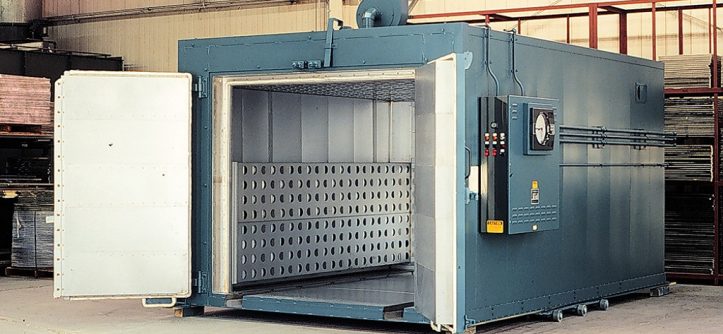Understanding the mechanisms of heat transfer in industrial ovens is critical to optimizing the efficiency and quality of heating processes. This knowledge is particularly essential when operating an industrial powder coating oven or powder coating machine. Here we will explore the three fundamental methods of heat transfer and their implications for industrial oven design and operation.
Conduction Heat Transfer
Conduction is the process through which heat is directly transmitted through a substance when there is a difference in temperature between adjoining regions, without movement of the material. In an industrial oven context, this is akin to the heat transfer from the oven walls and shelves to the metal parts placed within. The molecular activity, as one part becomes hot, its kinetic energy increases and this energy is passed along to neighboring cooler parts. Industrial ovens, especially powder coating ovens, need to have materials with high thermal conductivity to ensure swift and even heating.
Convection Heat Transfer
Moving away from direct contact, convection heat transfer is about the movement caused within fluids (gas or liquid) by the difference in temperature and density. An industrial oven harnesses this mechanism to circulate heat, utilizing either natural or forced convection methods. Natural convection occurs due to the rise of hot air and the sinking of cooler air, while in forced convection, fans or pumps move the air around. For instance, a powder coating machine may employ a fan to ensure the hot air is evenly distributed, thus preventing hotspots and ensuring a uniform coating.
Radiation Heat Transfer
Radiation transfers heat through electromagnetic waves and doesn’t require a medium, like air, to work. This means that an object can be heated by radiation even if it is placed in a vacuum. In the industrial oven space, infrared heating is a common application of radiation heat transfer. This method can be particularly efficient for powder coating processes as it can quickly raise the surface temperature of the coated item without wasting energy on heating the surrounding air.
Heat Transfer in Batch Ovens
Batch ovens are designed to heat items in groups or batches. The heat transfer within these ovens is often a combination of conduction, convection, and radiation. The way heat is applied can affect the product’s quality and the oven’s efficiency. For example, ensuring proper spacing between items can improve convection heat transfer, leading to a more uniform cure in an industrial powder coating oven.
Heat Transfer in Conveyor Ovens
Conveyor ovens are the dynamos of continuous production, providing a consistent and controlled environment for items as they move through the heating process. The heat transfer in such an oven must be meticulously managed to maintain a uniform temperature across the different stages of the oven. An efficient industrial oven of this type would be designed to maximize convection heat transfer, often with carefully calibrated jets of hot air that target the products on the conveyor to ensure even baking or coating.
Insulation and Heat Transfer Efficiency
A well-insulated industrial oven is the cornerstone of energy efficiency and consistent heating. Insulation serves to minimize heat loss through conduction, ensuring that the heat stays where it’s needed — inside the oven. This is particularly important in the high-temperature environments required for powder coating, where energy consumption can be significant. Quality insulation contributes to a stable thermal environment, reducing the heat-up time and thereby saving energy.
Controlling Heat Transfer for Uniform Baking
The ultimate goal of mastering heat transfer in an industrial oven is to achieve uniform heating — essential for processes like powder coating, where the quality of the final product can be compromised by uneven baking. Sophisticated control systems are employed to regulate temperature and airflow, adapting to the specific requirements of the materials being processed. These systems must be finely tuned to respond to the heat transfer dynamics unique to each oven design, whether it’s a batch or a conveyor system, to ensure consistent, high-quality output.
In conclusion, the interplay of conduction, convection, and radiation heat transfer mechanisms is crucial to the performance of industrial ovens. Whether it’s a powder coating machine or a large-scale industrial oven, understanding and controlling these mechanisms is key to energy efficiency and high-quality production. The design and operation of these ovens must consider the subtle balance required to achieve uniform heat distribution and optimal coating or baking results. With careful consideration and control of these heat transfer processes, industrial ovens can operate at peak efficiency, delivering superior quality products time and time again.
Tags: industrial oven for baking, industrial oven manufacturers, industrial oven uses




Leave a Reply